Blog post by AEL Summer Scholarship student Aldrianna Manalansan. Images courtesy of Taring Padi. Photos: Aldrianna Manalansan.
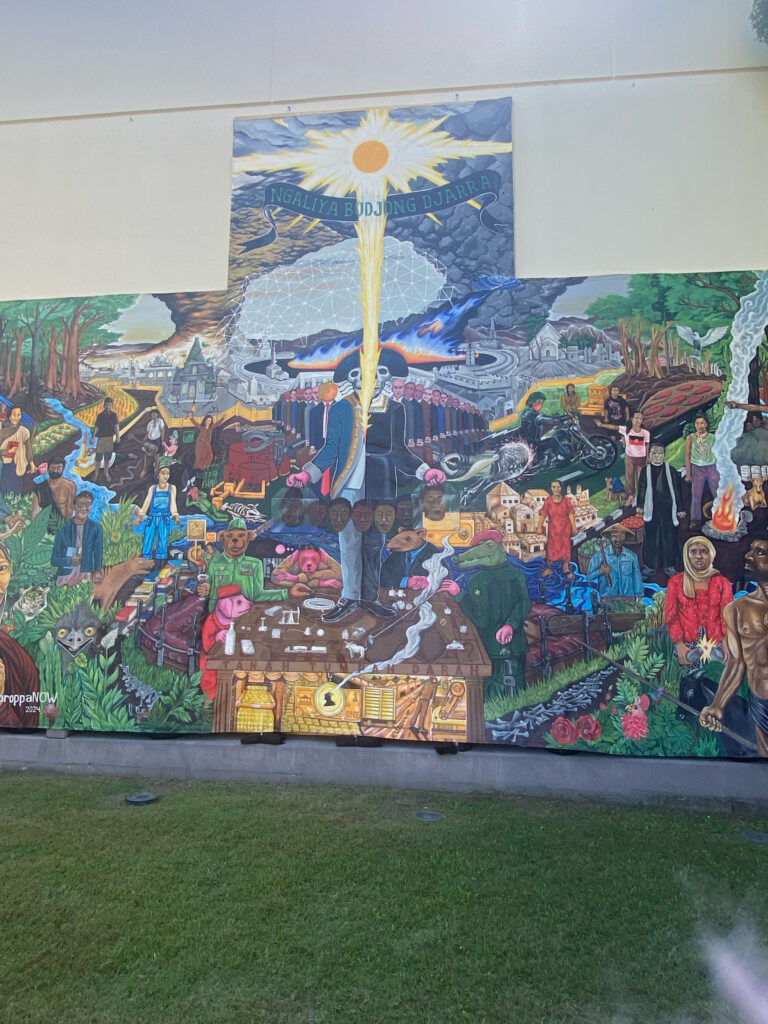
Taring Padi is an artistic collective based in Yogyakarta, Indonesia. The group is prominent for their portrayal of the people’s struggle against capitalism, corruption, military violence, environmental destruction, and racism within their artworks. The name ‘Taring Padi’ refers to the fang or spiky end of the rice plant, which can cause itchiness when in contact with the skin. The collective aims to create an “itchy” effect on those in power by resisting government oppression and advocating for social change and empowerment.
The group was founded in 1998 by art students and activists from the Indonesian Art Institute in response to the violence and exploitation of the people under the Suharto government. Since the introduction of democracy in Indonesia, they have continued to create political art, musical ensembles and street theatre with themes directly linked to political and societal issues. They work with local communities in Indonesia, in “places where they work and learn together”. Since its formation more than 25 years ago, hundreds of people have been involved with the collective in one capacity or another.
In February and March of 2024, Taring Padi visited Australia for the Tanah Tumpah Darah exhibition in collaboration with the Aboriginal collective proppaNow. Their work is displayed in the Griffith University Art Museum and consists of woodcut posters and prints, cardboard puppets (wayang kardus) and large-scale banners. As a participant in the Arts Education Law Summer Scholarship (AEL) Program at Griffith University, I had the privilege of speaking with members of Taring Padi, and in particular, Dr Alexander Supartono, to gain insight into their creative process and the concerns they had moving forward as a collective. Through the AEL Program, I was able to immerse myself in learning about Taring Padi and their purpose. Additionally, I gained a new appreciation for creative expression and a deeper understanding of how cultural and social issues are reflected in various art forms produced by artists from diverse backgrounds.
Interview with Dr Alexander Supartono
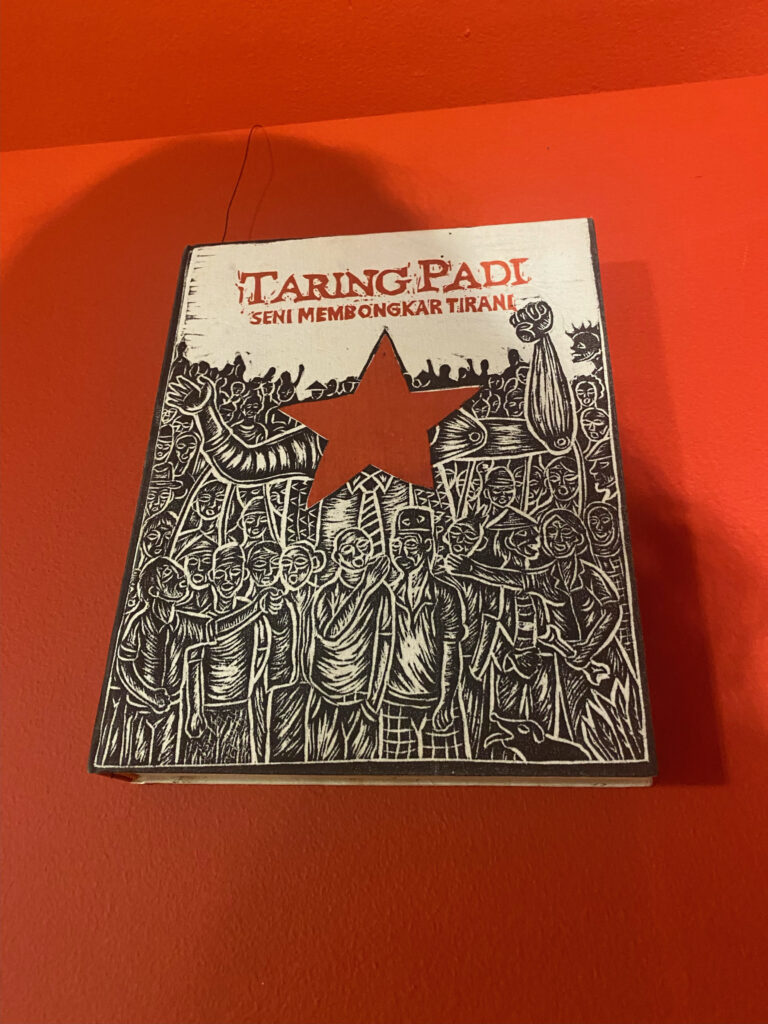
I had the privilege of interviewing Dr Alexander Supartono, a lecturer at Edinburgh Napier University and a member of Taring Padi, over Zoom. We had a candid conversation surrounding their work and the messages they hoped to convey.
Having limited knowledge of the context surrounding the collective, I asked how Taring Padi ensures that the values, messages, and beliefs of the group are portrayed in their artwork.
Firstly, Alex clarified that Taring Padi does not make “art”. Their group manifesto, the “Five Evils of Culture,” rejects the concept of art for the sake of art.
In the manifesto, the group condemns how artists capitalise on the people’s struggles and the subsequent judgement made by institutions, such as museums, on the value of art by comparing artists’ works. They are critical of artists who make art without care for the community’s interests. Alex explained that the works produced by the collective are in direct relation to the current political and social demands of the public, and this ensures that the collective’s core values of activism are not distorted.
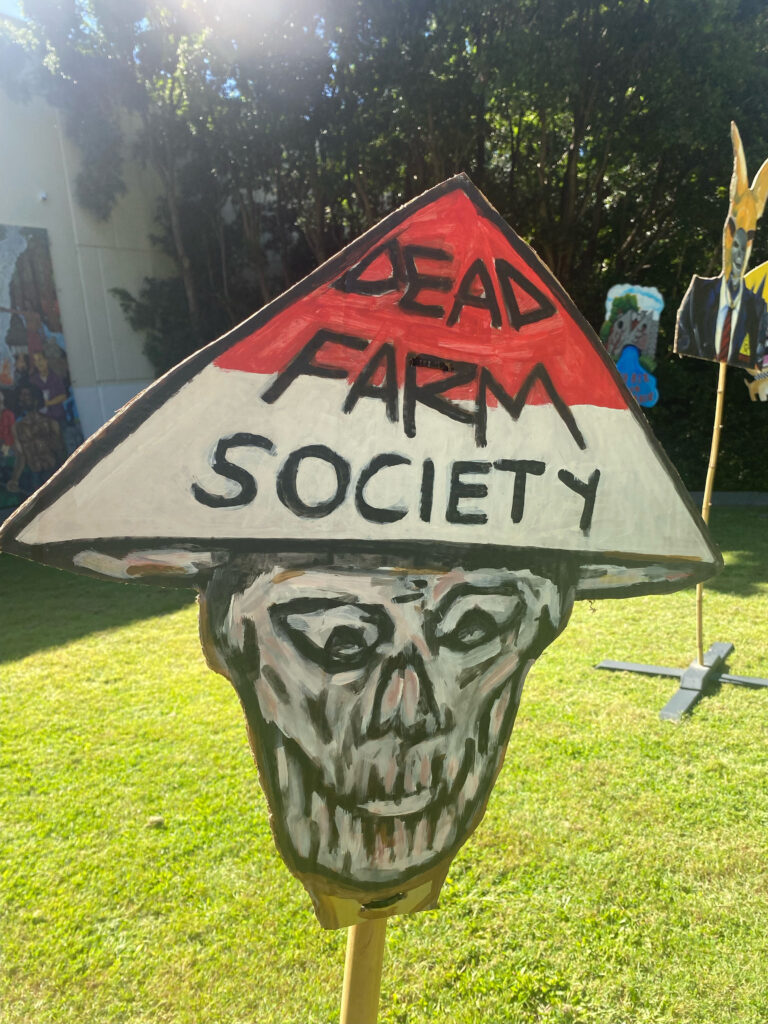
Taring Padi works with themes such as democratic freedom, inequality, and notably, land rights and farmer rights. One notable project by Taring Padi is their collaboration with the rural farming community, Kulon Progo. The Kulon Progo farmers have resisted the large-scale development of the New Yogyakarta International Airport since 2011.
The villagers opposed the construction as it would lead to evictions from farmlands and excavation of coastal lands, resulting in ecological concerns due to the destruction of sand dunes that prevent coastal erosion, tsunamis and more. Taring Padi worked with the villagers in Kulon Progo to create cardboard posters for protesting and the banner, ‘Rejection Solidarity’, highlighting their struggles for land rights and the anti-sand mining movement.
The Yeronga Paint Factory
In March 2024, I visited the Yeronga Paint Factory, where the Taring Padi members worked on the banner Ngaliya Budong Djarra (Our Mother Earth) in collaboration with proppaNOW. There was a jovial and welcoming atmosphere as I entered the space. Each section served a purpose, from the makeshift kitchen on the right, the members on a forklift working on the large banner to the left, and musical instruments, paint, and cardboard puppets at the back. There was an ecosystem within the collective where members could immerse themselves in each other’s company, create art, and eat good food.
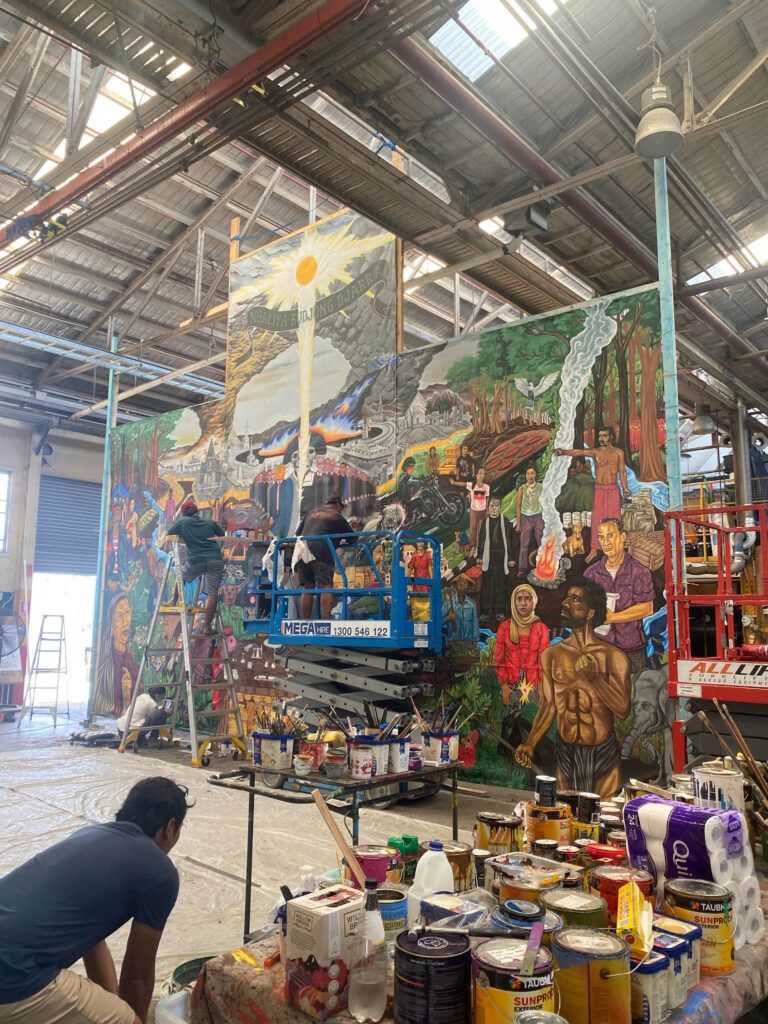
Gotong Royong – living together, working together – is an Indonesian communal tradition to accomplish a task or project as a group.
I met Ladija, who is pursuing her Master’s Degree in Management at the Indonesia Institute of the Arts, Yogyakarta. . She joined Taring Padi in 2020. She was also present during documenta fifteen, which was her first time travelling overseas with Taring Padi. I asked what it was like to have gone through that experience, and she stated that it was a difficult time for everyone. There was a lot of back-and-forth conversation between the members and the organisers of documenta, ruangruapa. When I asked how she got involved with the collective, she stated that she volunteered and was writing a piece on the collective (much as I am now). She told me how much she enjoyed being a part of the collective and that money cannot replace the value of the experience.
I spoke briefly with Bayu, who was painting a cardboard puppet. The wayang kardus serve various purposes, from protecting members in extreme weather to concealing their identity from police during protests. The puppets all addressed themes that the group discussed during ‘nongkrong’. Bayu told me that the puppets lined up in the back of the room were samples they would show during the cardboard puppetry workshops. Taring Padi utilises these workshops to connect with the locals and provide them with ways to creatively express their concerns regarding social justice, human rights, or any other issue of importance.
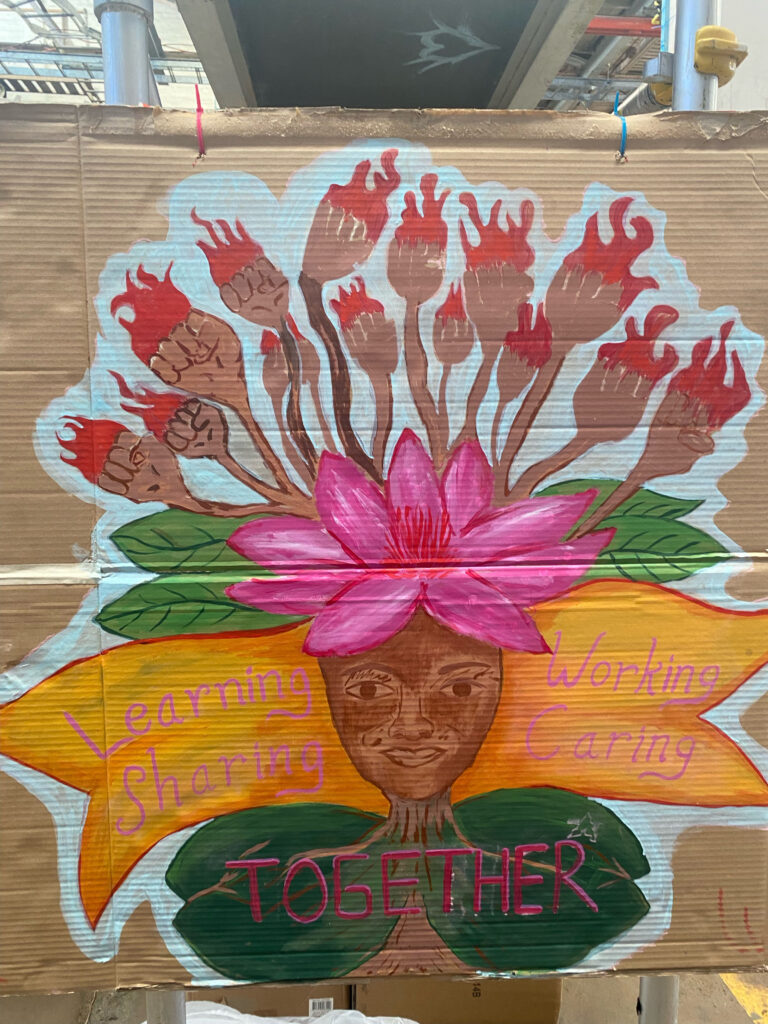
Ladija showed me her cardboard poster from above, which shows a person with a lotus as its central piece. She picked the lotus as it could grow in the mud; despite not being the best place for a plant to grow, it goes against all odds to develop and turn into a beautiful flower. The flower buds at the top, she affirmed, turned into human fists to show resistance to all the things that were against art.
Bayu also had an alternate practice and his own individual style of art. He stated that Taring Padi advocates for individualism despite being a collective. When publishing their writings, interviews, or artworks, Taring Padi allows the creator’s name to be signed on their works. However, banners and works produced by the collective or made with other members must be under the Taring Padi name.
Nongkrong – the process of hanging out
The collective is distinct in their approach to determining the themes of their work through the process of ‘nongkrong’ which colloquially translates to ‘hanging out’. Historically, the group would meet at their headquarters in Yogyakarta; however, with the group now being spread internationally, they now use modern technology to connect. In Indonesia, during nongkrong, each member of the group has the right to express their views, ideas, concerns, or any new topics they want to explore informally. I found their use of technology to be quite interesting. They regularly use Zoom meetings and stay connected with members who could not attend overseas or were not part of the exhibition. This is how the group decides on future projects, funding, materials, and the overall management of the group.
Mudflow in the village of Porong, East Java
The Sidaorjo mud disaster, also known as the Lapindo mudflow, marked a significant environmental catastrophe in Indonesia. On May 29 2006, an eruption of mud, steam, and water engulfed the town of Porong, Sidoarjo and displaced around 50,000 people overnight. In response, the President of Indonesia enacted Decree 14/2007, Article 5, which mandated the Lapindo company to acquire the lost assets of victims and compensate them according to their value. Subsequently, the lawsuits initiated by NGOs such as the Indonesian Legal Aid Foundation and Indonesian Environmental Foundation – were dismissed against Lapindo and the Indonesian Government. The Indonesian Supreme Court ruled that the eruption was a natural disaster, not an industrial one. Therefore, Lapindo was relieved of further legal obligations to compensate all mudflow victims, leading to the cessation of funding for the acquisition process in 2008. Lapindo asserted that any payment made to the victims was solely part of the company’s social solidarity efforts.
“We live in with the people” and “We form special connections… we join protest and movements” – Ladija, Taring Padi
In 2010, Taring Padi members arrived at the village in solidarity with mudflow victims by practising a lived-in approach whereby they slept, ate, and lived the way the villagers did. This approach allows Taring Padi to gain a deeper understanding of the villager’s experiences and the challenges they faced. During their visit, they taught the villagers how to make posters, T-shirts, and songs while organising protests to demand change. However, Ladija remarked that most of these protests the collective organised and participated in did not result in legislative or regulatory changes.
Despite regulations passed by the government, the Natural Commission of Human Rights found Lapindo and the government negligent in addressing the needs of the victims. The commission found at least 15 human rights violations for the mudflow victims, encompassing the right to settlement, food, healthcare, education, security, and employment. Many villagers have developed health issues such as respiratory problems attributed to the polluted air emanating from the mud volcanoes. Additionally, researchers discovered the Lapindo mud contained chemicals that cause cancer. Since 2006, the mudflow has continued to follow unabated.
After 25 years since the creation of Taring Padi, they continue to persist in their mission to empower those silenced. The group remains dedicated to working with communities and small villages like Porong by imparting peaceful ways to protest and educating them on the significance of their voice as their stories must be heard.
The future & new generation of Taring Padi
Visually, Taring Padi’s works have been described as uncompromising due to their depiction of sensitive themes. Taring Padi uses art as an instrument to spread their message in a manner transcending language, cultural, and geographical differences. It can create a sense of solidarity among people facing the same struggles. Their artwork provokes reflection among viewers and evokes a sense of necessity while also compelling common folk to fight for change. I asked Alex about his views regarding the digitalisation of art, replication, and Artifical Intelligence (‘AI’). He said this was something that Taring Padi was not against. He welcomed the replication of art to help get their message across. Alex stated the only thing that might be of concern is that it would take away the collaborative aspect of the works, which is an integral part of Taring Padi and of wanting to share their experiences and learning.
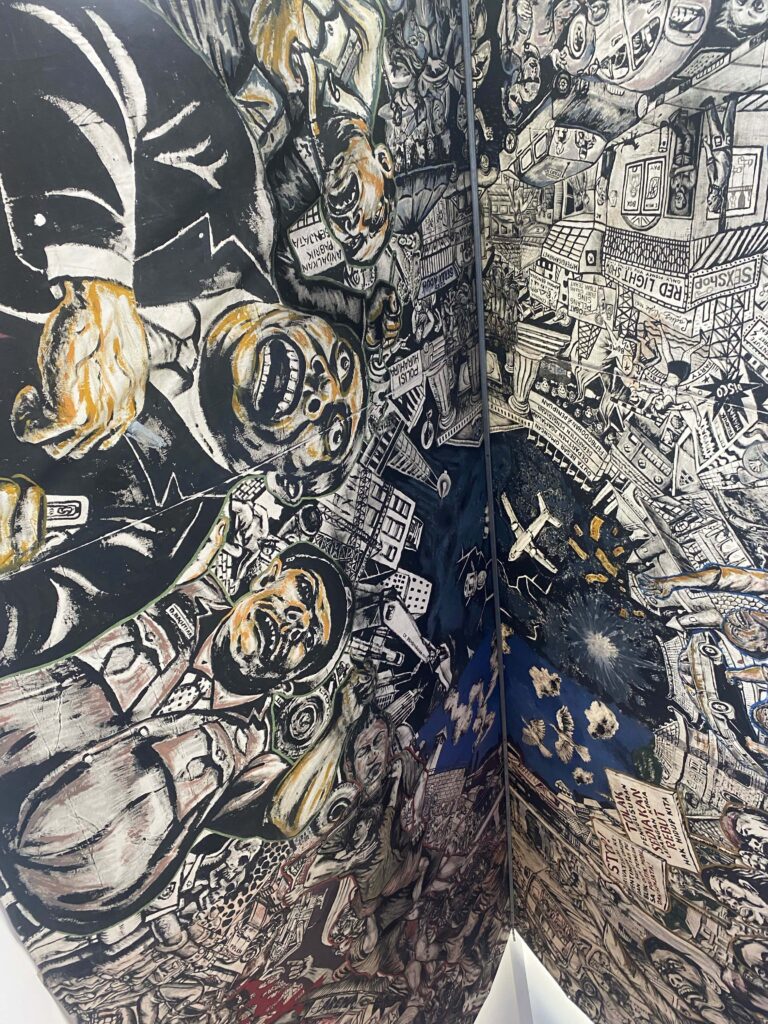
I asked Ladija how Taring Padi will adapt to an increased demand for their presence in international art spheres, with exhibits in Germany, Amsterdam, and Brazil already taking place, and an exhibit in Australia seeing the largest number of members gathered in one space (13). She said reflection. Taring Padi is increasingly open to collaboration with government bodies and institutions, particularly when it results in good outcomes for the community. As members recount producing more pieces than ever before, the demand for Taring Padi to ‘create’ has risen. However, the limited time to reflect between each international visit prevents members from sharing experiences among themselves, and perhaps from developing the messages they aim to highlight.
During the symposium at GUAM, artists such as Vernon Ah Kee from proppaNOW reflected on his commitment to advocating for Indigenous rights despite his previous struggles and the personal risk to his own freedom. Reflecting on our freedom to express our political beliefs is crucial in ensuring we are all equal, much like Taring Padi. We should consider the power of our voice as a community and advocate for those where the system is failing.
As a future lawyer, I hope to advocate and promote public interests above my own, challenge my moral convictions, and take the initiative to bridge the gap between the law and the people. I must be mindful of my privilege in the legal profession and my responsibility to recognise the impact my words and actions have on others and society as a whole. Our generation, along with those that follow can learn valuable lessons from the collective ethos of Taring Padi and proppaNow – to learn together, work together, and fight for the common good.
Taring Padi: Tanah Tumpah Darah is on at Griffith University Art Museum from 29 February to 25 May 2024. More information can be found here.